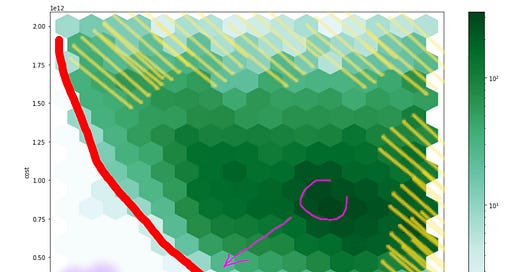On the dilemma between lives and economy
What can be illustrated in the pandemic simulation covidgame.info
Tens of thousands of people have already played the CovidGame.info simulation, and I think that the results illustrate few things about this the dilemma of "deaths" vs "economy" when implementing anti-epidemic measures. (In terms of principles, not exact numbers.)
The figure is a frequency map of how different games turned out, the vertical axis is the cost (in trillion CZK), the horizontal axis is the number of dead (note the logarithmic scale), the shading indicates how many games turned out that way.
The white/green boundary can be thought of as the Pareto frontier - highlighted in red. If you move right along this boundary, you are really already solving the dilemma of whether to "money" or "lives". Depending on what price you assign to the health consequences, the "right" solution is more or less to the right.
What I find realistic about this
1. the border looks different and runs in different places than most people imagine!
The intuitive and completely wrong idea of many people, including some of the people who decide things in the Czech Republic, was that there was some pretty direct proportionality between economic losses and lives saved. I.e., for example, having losses of around 1000 dead is twice as expensive as having losses of around 2000 dead in a month. In this naive model, then, low casualties mean that the measures were "too strict" and "too expensive".
In the simulation and in reality this is not the case.
2. The vast majority of the simulation runs were very far from that Pareto limit. The purple circle indicates the most typical results people achieve. It can be seen that a major improvement over such a "normal" approach is possible, leading to lower costs, at the same time as much fewer deaths. (indicated by the purple arrow)
3. The typical improvement option for most games from these typical progressions is to introduce measures "at the right time".
4. It is not at all difficult to achieve both very high costs and many dead
It is probably worth pointing out a few ways in which the game differs from reality
1. Testing and tracing in the game works much like in the Czech Republic - up to a certain limit it helps noticeably, above it not so much.
Border closures in the game also work roughly similarly to the Czech Republic and elsewhere in the EU. Closed borders practically mean that tens of thousands of people per day flow across them: being tested is fine, but it doesn't catch infected people who haven't multiplied enough at the time of testing, or who get infected after testing, perhaps on the way. Travellers across the border are also reported and hypothetically isolated, but this isolation is neither strict nor controlled.
The purple spots at the bottom left are solutions that are unfortunately rather unavailable with these restrictions and inconsistent approach in Europe - like Taiwan and New Zealand.
(I pointed out before the summer 2020 that the whole of EU can become "greenzone" with coordinated action, but only with coordinated action.)
In practice, more testing is possible. If we added that to the game, it would be a no-brainer, something you definitely want.
2. Of course the economic damage number is illustrative - it's very difficult to enumerate the economic damage of a measure, especially if you include long-term damage. Appropriate offsets are often likely to be a good investment, and will yield long-term gains in taxes, etc.
3. Of course, the game does not realistically capture the mood of society and all the political constraints on possible strategies, which means that the game allows trying quite extreme approaches, either uncontrolled spread slowed down just by scare response, or conversely a strategy involving e.g. keeping services closed all the time and compensating everything generously, which has as the "only" disadvantage extreme indebtedness (highlighted in yellow shading). I think this is more useful in the case of the simulator.
(Btw …if you can write a realistic simulator of public sentiment and the political process as a piece of software, please by all means contact me! :-)
(note: a simulation like this is a simplification of a model that can at most illustrate the principles, the goal is not to have some "exact numbers" or even a completely accurate run of that boundary)



